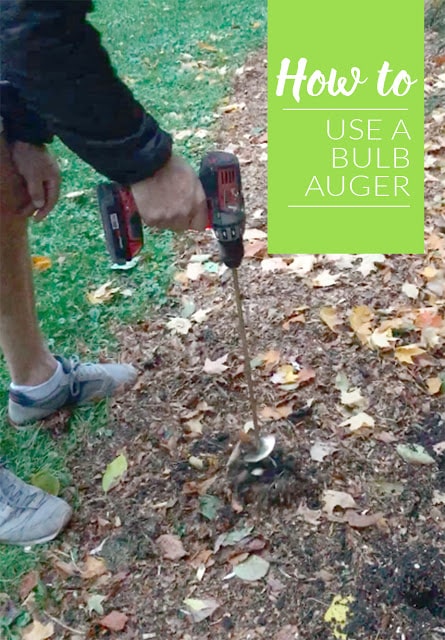So I told Mr. Much More Patient we could have mass quantities of daffodils if he didn’t balk at the cost and would agree to help plant them.
And that’s how we ended up planting 400 daffodils this week.
When I’m planting daffodils in the garden proper, I like to dig big holes and plant them en masse, but that approach wouldn’t work well for the woods. For one, there are a lot of roots around and digging big holes is not easily done. I also bought varieties that are supposed to naturalize (i.e. multiply) more easily, so wanted to give them enough room to do their thing in the future. That meant planting them individually and there is no better way to do that than with a bulb auger.
Think of a bulb auger as a really big drill bit for a power drill. They come in different lengths, but most seem to be in the 24-inch range. In my opinion, bigger is better because that means less bending over. It does take a little practice to get the hang of the auger though, so here are a few tips to make sure you don’t spin your hand off.
 |
| Set the drill torque on the drill setting and on a lower speed if you have a variable-speed drill. |
Put the auger in the drill the same way you’d fit in any drill or screwdriver bit. Then you want to turn the torque setting to the drill setting. If you have a drill with multiple speeds, put in on a lower speed setting. Our Milwaukee drill has two speeds and we run it on the slower speed for this.
Drilling a hole with a bulb auger is not the same as drilling a hole in a piece of wood, where you generally want to keep pushing. If you push like heck when you drill a hole in the dirt at some point the dirt (or more likely the roots, rock or something under the soil) is going to win and the auger will stop spinning but your arm won’t. I’m not kidding … your arm keeps spinning. And it hurts. This is why you want it on a lower speed.
In order to avoid that, work the auger up and down as you drill, gradually working it down into the soil. If it does get stuck, don’t try to push through it. Reverse the drill, back up a little and then start working up and down again until you’ve got the hole drilled to the depth you want (about 6 to 8 inches for daffodils, but they aren’t overly fussy).
Doing the up and down motion leaves a lovely little pile of soil around each hole, so it’s easy to refill after you put a bulb in the hole. One note: We noticed that we were using up the batteries on the drill quickly when we were whipping through holes so quickly. We went through a battery about every 100 holes. So make sure you have a fully charged battery and if you have a spare battery make sure that’s good to go too.
Working with two people we were able to crank out those bulbs in no time, probably about an hour total. Mr. Much More Patient was on drill duty and I plunked the bulbs in the holes and covered them as I went. I found it was much easier to dump the bulbs into a trug rather than try to fish them out of a bag every time.
There’s plenty of time to plant bulbs still. In fact you can pretty much do it as long as you can get in the ground, but planting bulbs in really cold ground, when it’s really cold outside, can’t be much fun.
If you’re in the market for a bulb auger, here are a few to check out.
[custom_code name=”amazon”]



6 Responses
I discovered a great additional use for these bulb augers. I have heavy clay soil in my yard and for the past couple of years have been using one of these to drill down into the soil and filling the holes with various types of organic material. Sometimes I use compost but a lot of times I just fill the holes with coffee grounds, banana peels, and any other kitchen scraps I have on hand. Basically, this creates cold compost holes that not only improves the texture and composition of the soil but also helps to promote worm populations. I’ve been extremely surprised and pleased with the results.
I combine this strategy with core aeration and topdressing for a comprehensive solution and am convinced that drilling into the soil using my bulb planter has made a real difference in the quality of my soil.
Just goes to show that sometimes products like this are good for more than they are advertised for!
Oh, and here’s a tip for the soil that builds up around the hole when you are digging. Place a paper plate on the ground where you are going to dig and hold it down with both feet while you drill. The auger will tear through the plate and then pile most of the dirt that you drill out onto the plate. It makes clean up super easy!
Thank you so much for this post. I always wanted a bulb augar, but thought it was too much trouble to use. Now I know differently! I can't see your recommended augars to check out at the end of the post. Can you list them in words?
Thank you for the tips! Let's see how this goes…
I've always wondered how these really work. Should have had one in the days when I was putting in bulbs in unplanted areas and lots of them. Gorgeous weather here and we have been indoors all day getting ready for a dinner party. It will be fun but this may be the last really great day this fall!